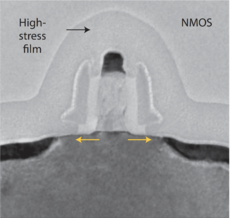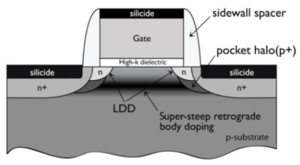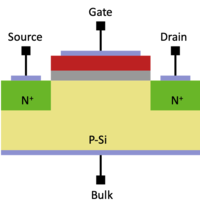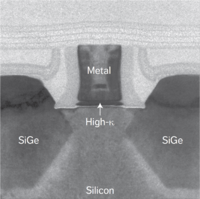Difference between revisions of "MOS Transistors"
| Line 83: | Line 83: | ||
** Does not model important regions such as moderate inversion | ** Does not model important regions such as moderate inversion | ||
| − | Challenge: How to accurately design when hand analysis is way off? | + | * '''Challenge''': How to accurately design when hand analysis is way off? |
| − | Answer: We will use the simulator as a "calculator" together with our "simple" models. | + | * '''Answer''': We will use the simulator as a "calculator" together with our "simple" models. |
== References == | == References == | ||
Revision as of 19:24, 17 August 2020
Analog circuits are generally sensitive to the nuances and details of transistor behavior, requiring precise and/or well-controlled voltages, currents, etc. Digital circuits, on the other hand, can have much larger margins of error due to their inherent noise margins and regenerative properties. Thus, we want to be able to model these nuances and details of transistor behavior in order to predict their effects on our circuits.
Contents
Transistor Models
Transistor models enable us to describe and predict the behavior of the circuits we build using these transistors by:
- Providing us with a window into the physical device characteristics (e.g. dimensions, material and device properties, etc.) and processes (e.g. drift/diffusion currents, tunneling, charge transfer, etc.), and
- Allowing us to perform easy to do "experiments" using simulators such as SPICE[1].
Levels of Abstraction
The complexity of transistor models can range from very simple models, such as modeling the transistor as a simple controlled switch, to very complex models such as BSIM[2] models with hundreds of parameters.
We choose a model based on the questions we want answered. For example:
- For predicting the digital (boolean) functionality of a static CMOS gate, we can simply model the transistor as a controlled switch.
- However, if we want to predict the performance of the CMOS gate, we might need to model the ON current of the transistor as a current source in series with a switch.
- For high-precision analog circuits, we might need a BSIM model to predict the noise performance, settling time, stability, etc.
Note that "questions" that are more complicated require more complex and mathematically intensive models. Thus, it is best to match the model complexity to the problem or question we want answered. Further note that different models can be used to answer different questions at different stages of the design process.
The Square-Law MOSFET Model
The widely known square-law MOSFET model is a good model for predicting the behavior of discrete and relatively large-sized transistors. It relates the drain saturation current to the gate-to-source voltage as:
-
(1)
-
Where is the electron mobility, is the gate-oxide capacitance per unit area, dependent on the permittivity and thickness of the gate oxide layer, and is the transistor threshold voltage.
However, the square-law model is inadequate for modeling short-channel behavior, since it is based on the following assumptions (not a complete list):
- The channel charge density is determined only by the vertical electric field due to .
- Drift velocity is set only by the lateral electric field due to .
- The mobility of electrons and holes are constant.
- There are no diffusion currents, and that when .
Submicron Transistors
Due to manufacturing constraints and limitations, the structure of a deep submicron (with channel lengths of 90nm and below) transistors can differ quite dramatically from the idealized structure shown in Fig. 1. For an simple overview of the CMOS fabrication process, you can watch Silicon Run I (1996).
The cross section of modern MOSFETs with lengths of 90nm, 65nm, and 45nm are shown in Figs. 2, 3 and 4.
 Figure 2: Intel 90nm MOSFET with tensile channel strain[3]. |

As we can see, the cross-section of these real transistors are very different from the idealized transistor in Fig. 1. A simplified cross-section of a submicron transistor is shown in Fig. 5. A few noteworthy characteristics of advanced MOSFETs:
- Gate Electrode
- Ultra-thin Gate Dielectrics
- Source/Drain Engineering
- Short-Channel Effects
- Retrograde Doping
- Pocket Implants
Process Variations
Short-Channel Effects
Threshold Voltage
- Halo Doping
- Reverse Short-Channel Effect
Drain Current
- Velocity Saturation
- Vertical Field Mobility Degradation
- The Subthreshold (Weak Inversion) Region
- The Moderate Inversion Region
Output Resistance
- Channel Length Modulation (CLM)
- Drain-Induced Barrier Lowering (DIBL)
- Substrate Current Body Effect (SCBE)
Transistor Models for Design
- Comprehensive models like BSIM:
- Industry standard
- Expertise needed to perform parameter extraction
- 40-100+ parameters: requires many assumptions to be useful as a "hand calculation model"
- Excellent for verification and modeling device variations
- Square-law, velocity-saturation model, small-signal models, or other "simple" models
- Best to build intuition
- Output resistance is the key to determine gain but is very hard to model
- Does not model important regions such as moderate inversion
- Challenge: How to accurately design when hand analysis is way off?
- Answer: We will use the simulator as a "calculator" together with our "simple" models.
References
- ↑ SPICE (Simulation Program with Integrated Circuit Emphasis) https://en.wikipedia.org/wiki/SPICE
- ↑ BSIM (Berkeley Short-channel IGFET Model) https://bsim.berkeley.edu/
- ↑ 3.0 3.1 3.2 M. T. Bohr and I. A. Young, CMOS Scaling Trends and Beyond, in IEEE Micro, vol. 37, no. 6, pp. 20-29, November/December 2017, doi: 10.1109/MM.2017.4241347. IEEExplore link
- ↑ Kim, Yong-bin, Challenges for Nanoscale MOSFETs and Emerging Nanoelectronics. Transactions on Electrical and Electronic Materials 11 (2010): 93-105. link
Further Reading
- M. T. Bohr and I. A. Young, CMOS Scaling Trends and Beyond, in IEEE Micro, vol. 37, no. 6, pp. 20-29, November/December 2017, doi: 10.1109/MM.2017.4241347. IEEExplore link
- Kim, Yong-bin, Challenges for Nanoscale MOSFETs and Emerging Nanoelectronics. Transactions on Electrical and Electronic Materials 11 (2010): 93-105. link











